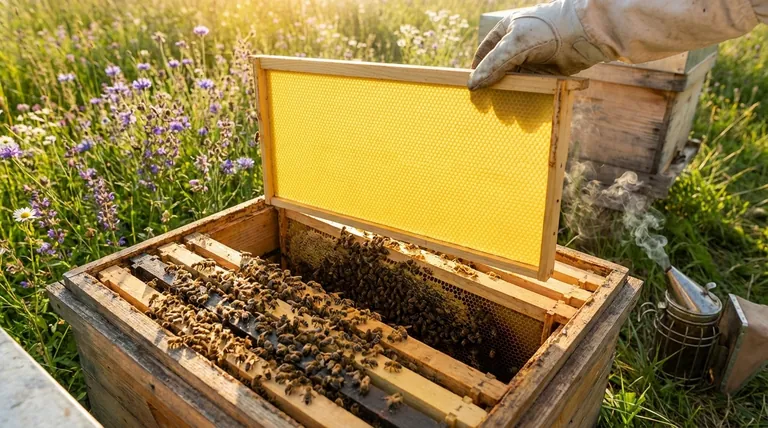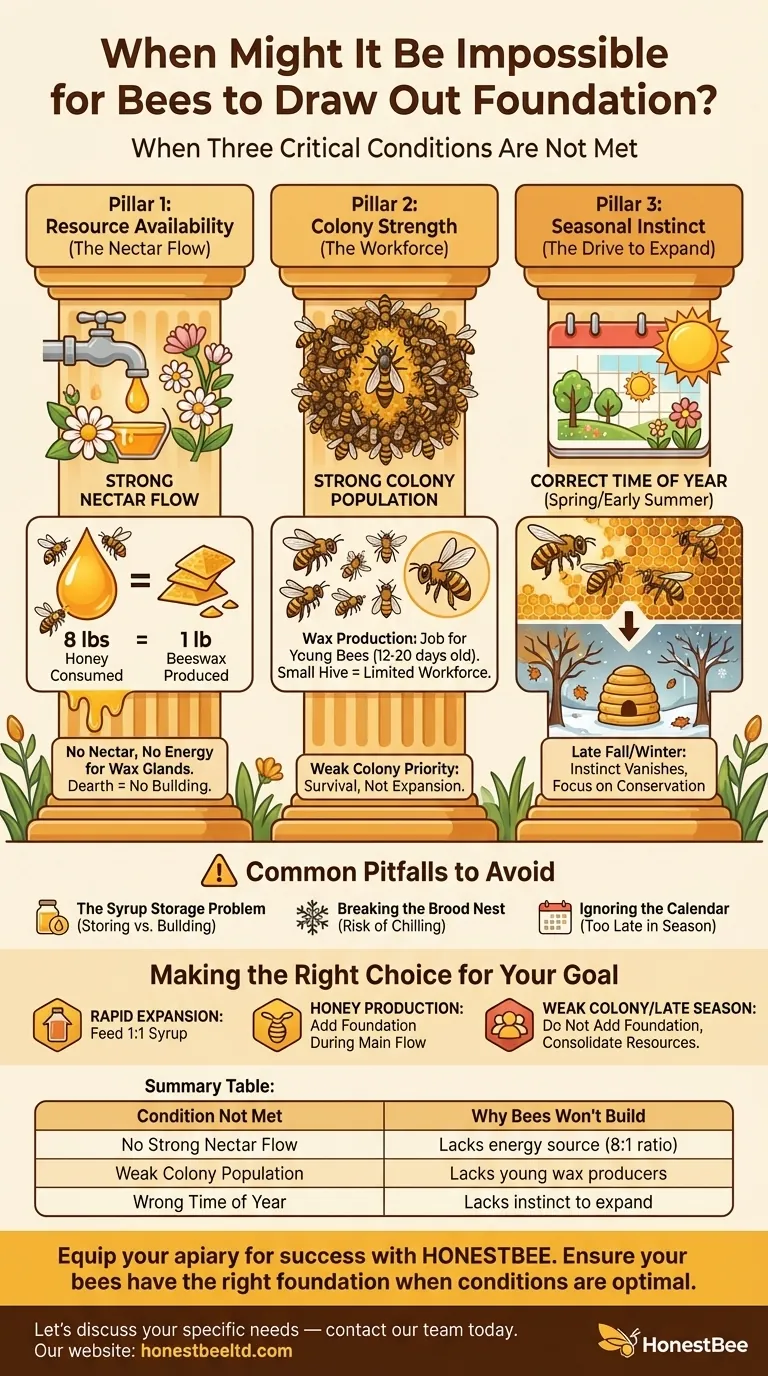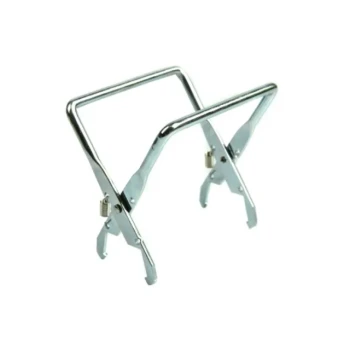It is impossible for bees to draw out foundation when three critical conditions are not met: a strong nectar flow, a sufficiently large colony population, and the correct time of year. Without the incoming resources and the biological drive to expand, a honeybee colony will conserve its energy and simply ignore any new foundation you provide.
A colony's ability to build honeycomb is not a constant; it is a direct reflection of its internal strength and external environment. Forcing a colony to build when it lacks the resources or motivation is a futile effort that misunderstands the fundamental biology of the hive.

The Three Pillars of Comb Construction
Successfully getting bees to draw out foundation depends on aligning your efforts with their natural capabilities. Think of it as a factory that requires raw materials, a workforce, and a production schedule.
Pillar 1: Resource Availability (The Nectar Flow)
Honeybees produce wax from specialized glands, a process that is incredibly energy-intensive. It is estimated that bees consume around eight pounds of honey to produce just one pound of beeswax.
This is why a strong nectar flow is the single most important factor. When nectar is abundant, bees have the surplus energy required to activate their wax glands and begin construction.
If the natural flow is weak or nonexistent (a period known as a dearth), bees will not sacrifice their precious food stores to build wax. In this scenario, you can simulate a nectar flow by feeding the colony a 1:1 sugar syrup to stimulate their wax glands.
Pillar 2: Colony Strength (The Workforce)
Wax production is a job for young worker bees, typically those between 12 and 20 days old. A small or weak colony simply does not have the population of bees in this age range to create a significant amount of wax.
A weak hive's priority is survival. Its limited workforce is dedicated to essential tasks like caring for the queen, raising the small amount of brood they can keep warm, and foraging for immediate needs.
Expecting a weak colony to draw multiple frames of foundation is unrealistic. At best, they may slowly work on a small patch of a single frame. The hive must be booming with bees to have the excess labor needed for large-scale construction projects.
Pillar 3: Seasonal Instinct (The Drive to Expand)
Honeybee colonies operate on an annual cycle. Their instinct to expand is strongest in the spring and early summer. This is when they are naturally driven to build comb to make space for the queen to lay eggs and to store the incoming nectar.
As the season progresses into late fall and winter, this instinct vanishes completely. The colony's focus shifts from expansion to conservation. Their goal is to consolidate their nest, maintain a cluster for warmth, and survive on their stored honey until spring. Adding foundation during this period is useless, as they have no biological urge to expand.
Common Pitfalls to Avoid
Understanding the "why" behind comb building helps you avoid common mistakes that can stress or hinder a colony.
The Syrup Storage Problem
When feeding a colony to stimulate wax production, be aware that if there is absolutely no natural nectar available, bees may simply store the syrup in existing cells rather than using the energy to build new comb. Feeding works best as a supplement, not a complete replacement for a natural flow.
Breaking the Brood Nest
A common technique is to place a frame of foundation between two drawn-out frames of brood to encourage building. However, doing this too aggressively, especially in a weaker colony or during cool weather, can be dangerous.
Spreading the brood nest too thin makes it difficult for the bees to maintain the required temperature (around 95°F / 35°C). This can chill the brood, killing the developing larvae and severely setting back the colony's growth.
Ignoring the Calendar
Adding a super full of new foundation in late August or September (in the Northern Hemisphere) is a classic beginner's mistake. The bees' seasonal drive is gone. The frames will remain untouched, and you will have wasted the opportunity to prepare the hive for winter.
Making the Right Choice for Your Goal
Apply these principles to your specific situation to ensure your bees have what they need to build.
- If your primary focus is rapid expansion: Feed a new or weak colony a steady supply of 1:1 syrup in the spring to simulate a strong nectar flow and provide the fuel for population growth and comb construction.
- If your primary focus is honey production: Add new foundation or supers only when the colony is strong and the main nectar flow has clearly begun. Let nature's abundance provide the fuel.
- If your colony is weak or the season is late: Do not add any new foundation. Focus on consolidating the hive's resources and ensuring it has enough drawn comb and stored honey to survive the coming winter.
Working with bees is about aligning your goals with their natural instincts and capacities.
Summary Table:
| Condition Not Met | Why Bees Won't Build |
|---|---|
| No Strong Nectar Flow | Lacks energy source (8 lbs honey = 1 lb wax). |
| Weak Colony Population | Lacks young bees (12-20 days old) for wax production. |
| Wrong Time of Year | Lacks instinct to expand (e.g., late fall/winter). |
Equip your apiary for success with HONESTBEE.
As a commercial beekeeper or distributor, you understand that colony strength and timing are everything. Ensure your bees have the right foundation and equipment to build strong, productive hives when conditions are optimal.
HONESTBEE supplies durable, high-quality beekeeping supplies and equipment through wholesale-focused operations, helping you maximize efficiency and honey production.
Let's discuss your specific needs — contact our team today to get the right equipment for your operation.
Visual Guide

Related Products
- Beeswax Foundation Sheets Beehive Foundation for Wholesale
- Food Grade Plastic bee Foundation for Bee Frames
- Colorful Silicone Beeswax Foundation Mold Mould for Beekeeping
- Manual Beeswax Comb Foundation Machine Wax Foundation Mill Embossing Machine
- Electric Beeswax Flat Sheet Machine with Operating Tray for Wax Processing
People Also Ask
- How do you store beeswax foundation? Prevent Wax Moth Damage and Preserve Quality
- What happens after the flattening and embossing process is complete? From Molten Wax to Solid Foundation
- What is 'foundation' in beekeeping, and why is it used? Optimize Hive Management & Honey Production
- What are the potential issues if the wax or dipping process is not properly managed? Avoid Cracks, Ripples, and Delamination
- What happens if foundation is given to colonies during a nectar dearth? Avoid Wasted Equipment and Stressed Bees



















